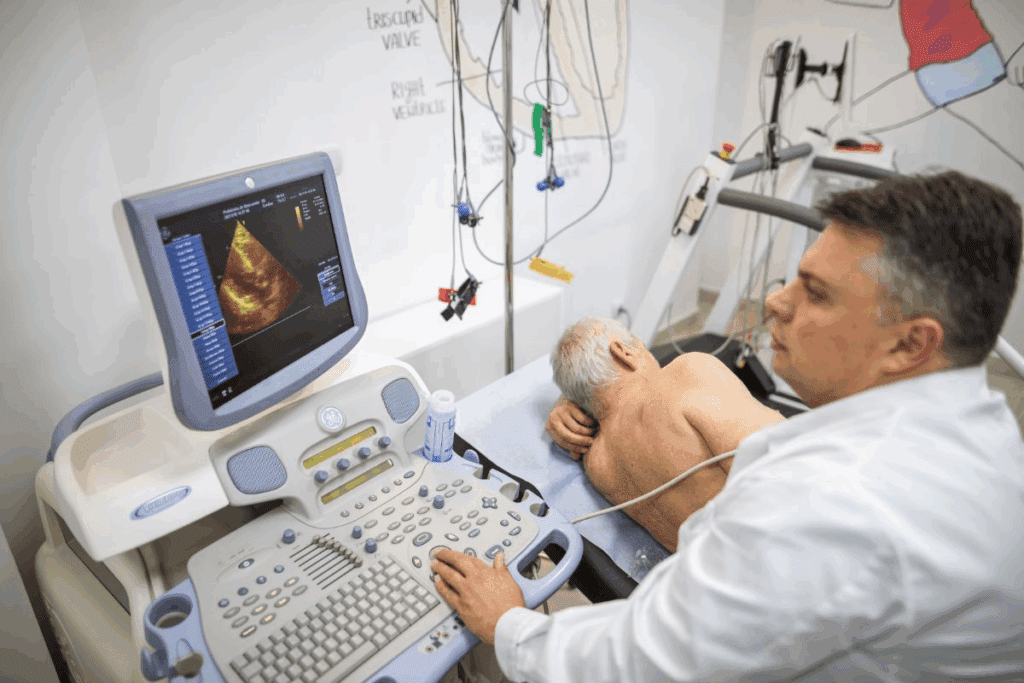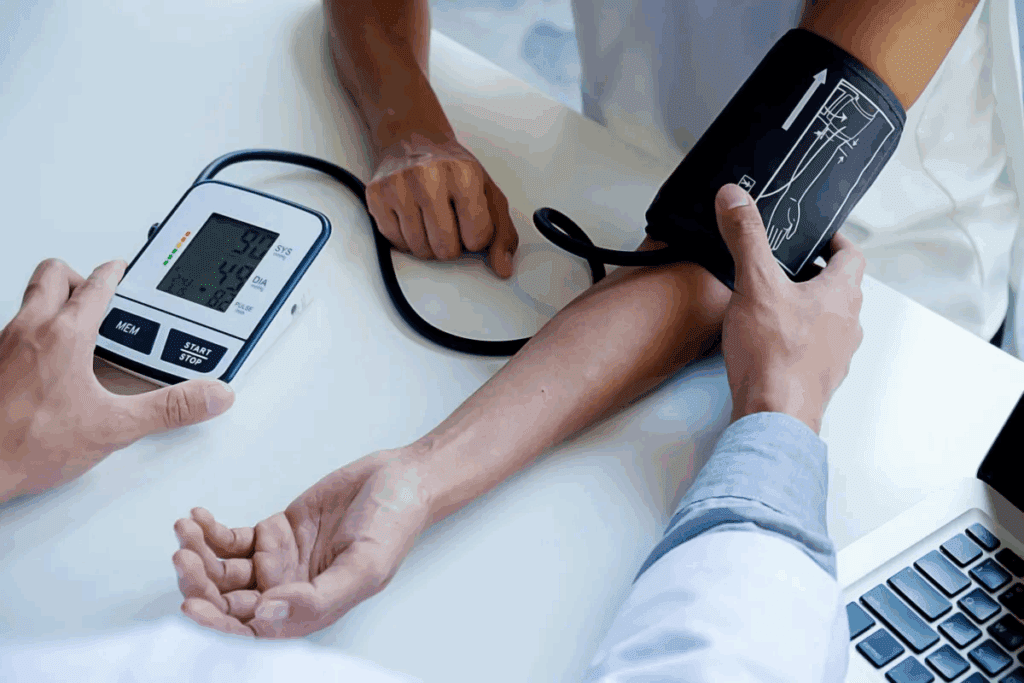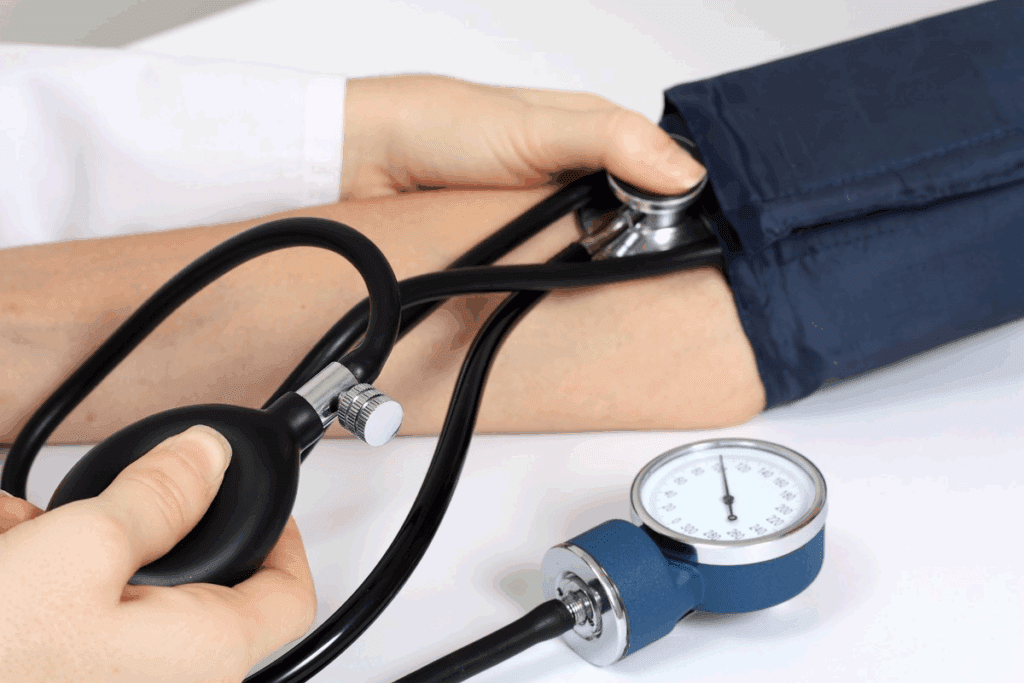
Knowing your blood pressure is key to keeping your heart healthy. At Liv Hospital, we focus on you and use the latest medical knowledge. High systolic blood pressure, also known as isolated systolic hypertension (ISH), means the top number of your blood pressure is too high. This number shows how hard your heart is pushing blood into your arteries.
Understand what causes systolic bp to be high and how to manage it properly.
When this number goes up, it can mean you’re at higher risk for heart problems. It’s important to know what it means and how to handle it. Doctors check your blood pressure every year and more often if needed to see if you have high blood pressure.

Blood pressure measurements give us important insights into our health. When we check blood pressure, we see two numbers. These numbers show how well our heart is doing at that moment.
Blood pressure is shown as two numbers: systolic and diastolic. Systolic blood pressure is the top number. It shows the pressure when the heart beats. Diastolic blood pressure is the bottom number. It shows the pressure when the heart rests between beats.
Normal blood pressure is below 120/80 mmHg. Keeping blood pressure in this range is key for heart health. Elevated blood pressure can cause serious problems, even without symptoms.
Systolic pressure is high if it’s over 130 mmHg, even with normal diastolic pressure. This is called isolated systolic hypertension. Knowing when your systolic pressure is high helps you manage it and avoid health risks.

Understanding Isolated Systolic Hypertension (ISH) is key to keeping your heart healthy. ISH happens when your systolic blood pressure is too high, but your diastolic pressure is normal.
Isolated Systolic Hypertension means your top blood pressure number (systolic) is over 130 mmHg. But your bottom number (diastolic) is under 80 mmHg. This is common in people over 70.
ISH and regular hypertension are different because of blood pressure readings. Regular hypertension has both numbers high. ISH has a high systolic number but a normal diastolic number. This difference is important for diagnosis and treatment.
As we get older, the risk of ISH goes up. This is because our arteries get stiffer and less flexible. Knowing this helps us manage ISH better.
| Age Group | Prevalence of ISH | Key Considerations |
| Under 50 | Low | Lifestyle factors play a significant role. |
| 50-69 | Moderate | Age-related changes start to manifest. |
| 70 and above | High | Arterial stiffness is a major contributing factor. |
High systolic blood pressure comes from many sources. These include getting older, our lifestyle, and health issues. Knowing these causes helps us prevent and treat high blood pressure better.
As we age, our arteries get stiffer. This makes it harder for them to move with each heartbeat. Arterial stiffness is a big reason for high blood pressure in older people.
Our lifestyle choices greatly affect our blood pressure. Being overweight, eating too much salt, smoking, and drinking too much alcohol can raise it. Not being active also makes it worse, raising the risk of high blood pressure.
Some health issues can also raise systolic blood pressure. These include diabetes, hyperthyroidism, obstructive sleep apnea, and kidney disease. It’s important to manage these conditions well to keep blood pressure healthy.
| Medical Condition | Effect on Systolic Blood Pressure |
| Diabetes | Increases risk of hypertension due to vascular damage |
| Hyperthyroidism | Can cause increased heart rate and blood pressure |
| Obstructive Sleep Apnea | Repeated interruptions in breathing can raise blood pressure |
| Kidney Disease | Fluid retention and vascular changes can increase blood pressure |
Understanding why systolic blood pressure goes up helps us take action. We can manage our condition and lower the risk of heart problems.
Knowing the risk factors for high systolic blood pressure is key to preventing it. This condition often has no symptoms, making it important to spot those at risk early.
Genetics play a big role in blood pressure risk. If your family, like parents, has high blood pressure, you might too. Studies show genes can affect how well your kidneys and blood vessels work.
Age is a big risk factor for high systolic blood pressure. As we get older, our blood vessels stiffen, raising blood pressure. People over 60 are at higher risk. Women, too, are more likely to get high blood pressure after menopause.
Some health issues raise blood pressure risk. These include high cholesterol, hyperthyroidism, heart valve disease, and diabetes. Keeping these conditions under control is key to avoiding high blood pressure.
Some medicines can raise blood pressure as a side effect. This includes antidepressants, NSAIDs, and decongestants. Always watch your blood pressure when starting new meds and talk to your doctor about any worries.
We summarize the key risk factors for elevated systolic blood pressure in the following table:
| Risk Factor | Description |
| Genetic Predisposition | Family history of hypertension increases individual risk |
| Age | Risk increases with age, specially over 60 years |
| Gender | Women, specially post-menopause, are at higher risk |
| Chronic Health Conditions | High cholesterol, hyperthyroidism, heart valve disease, diabetes |
| Medication Side Effects | Certain antidepressants, NSAIDs, decongestants |
By knowing these risk factors, people can take steps to manage their blood pressure. This can help avoid complications from high systolic blood pressure.
High systolic blood pressure readings can be concerning. There are several common scenarios that might explain why this is happening to you. Understanding these factors is key to managing your blood pressure effectively.
White coat hypertension is a common phenomenon. It happens when your blood pressure goes up during medical visits. This is often due to anxiety or stress from the clinical environment. It doesn’t mean you have chronic high blood pressure, but it’s a sign to regularly check your blood pressure.
Stress and anxiety can temporarily make your arteries constrict. This releases hormones like adrenaline and cortisol, which can raise your systolic blood pressure. Managing stress through relaxation techniques such as deep breathing, meditation, or yoga can help mitigate this effect.
Physical activity can temporarily increase your blood pressure. This is normal as your heart rate and blood flow increase to meet your muscles’ oxygen demands. Regular physical activity can help lower your resting blood pressure over time.
Blood pressure naturally fluctuates throughout the day. It typically peaks in the late morning and early afternoon, then decreases during sleep. Understanding these natural fluctuations can help you better interpret your blood pressure readings.
| Factor | Effect on Systolic BP | Management Tip |
| White Coat Hypertension | Elevated BP in clinical settings | Monitor BP regularly at home |
| Stress and Anxiety | Temporary increase in BP | Practice relaxation techniques |
| Recent Physical Activity | Temporary increase in BP | Regular exercise can lower resting BP |
| Time of Day Variations | Natural fluctuations | Monitor BP at different times |
By understanding these common scenarios, you can manage your systolic blood pressure more effectively. If you’re concerned about your readings, it’s always best to consult with a healthcare professional.
It’s important to understand the risks of high systolic blood pressure. This condition can cause serious health problems like heart attacks, strokes, and kidney disease. Knowing these risks helps in managing blood pressure effectively.
High systolic blood pressure increases the risk of heart disease. The pressure can damage artery walls, leading to plaque buildup and atherosclerosis. Medical Expert, a cardiologist, says, “High blood pressure is a major risk factor for heart disease. Managing it is key to preventing heart attacks and strokes.”
Some cardiovascular risks include:
High systolic blood pressure can damage various organs. The kidneys, eyes, and heart are most at risk.
For example, it can cause:
“The damage caused by high blood pressure is often silent, making regular monitoring critical for early detection and management.” –
American Heart Association
The long-term risks of high systolic blood pressure are significant. Studies show that uncontrolled high blood pressure increases mortality risk. Managing high systolic blood pressure is key to reducing premature death risk.
The health implications of high systolic blood pressure are wide-ranging. They can greatly affect an individual’s quality of life and longevity. It’s vital to take proactive steps to manage and control high systolic blood pressure.
It’s key to accurately diagnose high systolic blood pressure to create good treatment plans. We use a mix of clinical checks and patient tracking to do this.
Healthcare experts must use the right methods to measure blood pressure. They use a trusted blood pressure monitor and make sure the patient is calm. It’s best for patients to not have caffeine, smoke, or exercise hard for 30 minutes before.
The patient should sit comfortably with their back straight, feet on the floor, and arm at heart level. Taking multiple readings at different times helps confirm the diagnosis.
Home monitoring and clinical readings are both important for diagnosing high systolic blood pressure. Home monitoring lets patients track their blood pressure at home, showing daily changes. Clinical readings, though, let doctors check other health factors in a controlled setting.
We suggest patients use a home blood pressure monitor that’s been checked for accuracy. Keeping a log of readings can help spot patterns and give doctors useful info.
We also do more tests to check the heart’s health. These tests include:
| Diagnostic Test | Purpose |
| Echocardiogram | Evaluates heart structure and function |
| Electrocardiogram (ECG) | Assesses heart rhythm and detects abnormalities |
| Blood Tests | Checks for underlying conditions like kidney disease or high cholesterol |
By using these tests together, we can accurately find high systolic blood pressure. Then, we can make a treatment plan that works well for each patient.
Managing high systolic blood pressure requires a mix of diet changes, exercise, and sometimes medicine. We’ll look at how to manage it through lifestyle changes and medication.
Making lifestyle changes is often the first step against high systolic blood pressure. These changes can greatly improve blood pressure and heart health.
| Lifestyle Modification | Impact on Systolic Blood Pressure |
| Reducing Salt Intake | Can lower systolic BP by 5-10 mmHg |
| Increasing Physical Activity | Can reduce systolic BP by 4-9 mmHg |
| Weight Loss | Can reduce systolic BP by 5 mmHg |
For severe hypertension or high risk of heart problems, medication might be needed. There are different types of blood pressure medicines, each with its own benefits and side effects.
It’s vital to work with a healthcare provider to find the best treatment plan. Everyone’s needs and situations are different.
We can lower the risk of heart diseases by following prevention strategies for healthy systolic pressure. A healthy lifestyle is key to avoiding high systolic blood pressure and heart problems.
The DASH diet helps manage and prevent high blood pressure. It’s low in sodium, high in potassium, and full of fruits and vegetables. Following the DASH diet can greatly improve heart health.
Nutritional Guidelines:
Regular exercise is key for healthy systolic blood pressure. It strengthens the heart, improves circulation, and boosts overall heart health.
Recommended Activities:
Keeping a healthy weight is vital to prevent high systolic blood pressure. Excess weight, mainly around the waist, raises the risk of hypertension.
| BMI Category | Health Risk |
| Normal (18.5-24.9) | Low |
| Overweight (25-29.9) | Moderate |
| Obese (30 or higher) | High |
Too much alcohol and smoking are big risks for high systolic blood pressure. Cutting down on alcohol and quitting smoking are key steps for heart health.
Tips for Reduction:
By adding these prevention strategies to daily life, people can greatly lower their risk of high systolic blood pressure and heart diseases.
It’s important to know when your systolic blood pressure is too high. We’ll show you when you should see a doctor. We’ll also talk about emergency situations and how often you should check your blood pressure.
High systolic blood pressure might not show symptoms until it’s very high. But, there are signs you shouldn’t ignore:
If your blood pressure is over 180/120 mm Hg and you have symptoms like chest pain, shortness of breath, dizziness, or severe headache, get emergency medical care right away. These could be signs of a hypertensive emergency, which needs quick treatment to avoid serious problems.
It’s key to regularly check your blood pressure, more so if you have high blood pressure or are at risk. Here’s what we suggest:
By staying on top of your blood pressure and knowing the warning signs, you can manage your condition well with your healthcare provider’s help.
High systolic blood pressure affects millions worldwide, often without symptoms. It’s key to understand its impact on heart health.
Controlling blood pressure can prevent heart attacks and strokes. Healthy habits, knowing risk factors, and timely medical care are essential.
We’ve covered high systolic blood pressure’s causes, risks, diagnosis, and treatments. Using this knowledge, people can manage their health and lower heart disease risks.
Managing high systolic blood pressure needs a full plan. This includes lifestyle changes and, if needed, medication. Working with doctors and making smart choices helps keep health in check.
A high systolic blood pressure means your heart’s force on artery walls is too strong. This can be a warning sign for heart health issues. It’s important to know why it happens and what it means.
A systolic pressure over 130 mmHg is considered high, even with normal diastolic pressure. This is called isolated systolic hypertension.
ISH is when your systolic blood pressure goes up but your diastolic stays normal. It’s common in older adults and raises heart disease risk.
High systolic blood pressure can come from getting older, lifestyle choices, and health issues. Knowing these causes helps in finding ways to prevent and treat it.
Managing high systolic blood pressure starts with healthy habits. This includes keeping a good weight, eating right, and exercising often. Sometimes, medicine is needed for severe cases.
Risk factors include your genes, age, gender, health conditions, and some medicines. Knowing these helps in early action and prevention.
Your systolic blood pressure can change for many reasons. This includes stress, recent exercise, and the time of day. Understanding these can help you manage your blood pressure better.
High systolic blood pressure can lead to serious problems like heart attacks, strokes, and kidney disease. Knowing these risks motivates people to control their blood pressure.
Diagnosing high systolic blood pressure involves accurate measurements. This includes home monitoring and doctor’s readings. Sometimes, more tests are needed to find underlying issues.
Treatment for high systolic blood pressure includes lifestyle changes and medicine. Eating well and exercising regularly can greatly help manage blood pressure.
To prevent high systolic blood pressure, follow the DASH diet, exercise regularly, keep a healthy weight, limit alcohol, and quit smoking. These habits can lower your risk.
See a doctor if you have severe symptoms like headaches or dizziness. Or if you’re at risk for heart problems. Regular checks are key for early detection and management.
World Health Organization. (2025). What Does It Mean When Your Systolic Blood. Retrieved from https://www.who.int/news-room/fact-sheets/detail/hypertension
Subscribe to our e-newsletter to stay informed about the latest innovations in the world of health and exclusive offers!
WhatsApp us